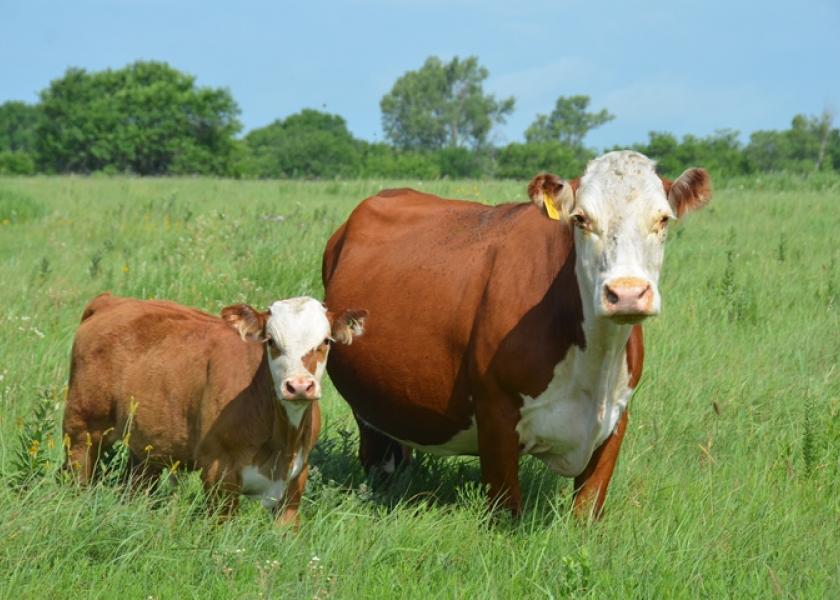Watch for Heat Stress, Summer Pneumonia in Beef Cattle

Hot, humid days can be dangerous and even deadly for cattle.
"The combination of heat and humidity creates stress on livestock because respiration is the predominate route for cooling," says Karl Hoppe, Extension livestock systems specialist at North Dakota State University's Carrington Research Extension Center. "Once cattle start to pant, some heat stress has occurred."
Keeping the internal body temperature at normal is possible with panting and adequate shade and water. Sometimes cattle will stand in ponds to cool off on a hot day.
"Healthy cattle can handle some heat stress," says Gerald Stokka, NDSU Extension veterinarian and livestock stewardship specialist. "However, too much heat, along with high humidity, can result in excessive heat stress, leading to death. Cattle can get relief from heat stress when the nights are cool. Night cooling for beef cattle occurs when the nighttime temperature falls below 72 degrees."
Producers also should be aware of the increased risk of "summer pneumonia" in suckling calves following heat stress. An increased respiratory rate, along with the stress of heat, may overwhelm the natural defense mechanisms of the lungs.
In calves that may be compromised due to inadequate intake and absorption of immunity (colostrum) from the dam, the risk is even greater.
Calves that develop pneumonia may not be discovered until too late in the course of the disease. Early signs may be calves off by themselves, dams with full udders, a drooped ear and rapid respiration. Adult cattle and yearlings that have experienced respiratory disease early in life or postweaning may have decreased lung capacity and will be at a greater risk of heat stress.
"Cattle that have damaged lungs due to pneumonia may die on the first moderately warm day," Stokka says.
He urges producers to consult with their veterinarian for confirmation of the heat stress diagnosis and for treatment options.
Night cooling allows the animal to cool off and get relief from heat stress. When night cooling doesn't exist, cattle have a difficult time handling the heat stress the next day.
"Usually, healthy cattle won't die from heat stress on the first hot day," Hoppe notes. "Cumulative days of heat stress without night cooling physiologically challenge cattle. After three days, some cattle can't handle the heat and humidity and die."
Brahma and brahma-crossbred cattle are more tolerant to elevated heat and humidity. Bos indicus breeds (Brahma crosses) often are included in the cow herd breeding program in southern states.
For northern cattle, reducing heat stress includes providing drinking water in adequate amounts and access to the water. Provide at least 2 inches of water per trough space per head. Providing shade also will help cattle reduce elevated body temperatures. Cattle will seek windy locations, wet places to stand, or ponds to wade in to help cool off.
Cattle with dark hides tend to show heat stress and have higher internal body temperature than cattle with lighter-colored hide.
For feedlot cattle, moving feeding time to later afternoon or evening will help reduce heat stress. Several hours after consuming a meal, the fermentation and digestion of feed creates heat. By feeding later in the day, the heat produced from digestion will develop during the night and not add to the daytime heat stress.
Usually, the fatter the cattle, the more difficulty in handling heat stress, Stokka says.
Heat stress can be forecast and is based on temperature, wind speed, humidity and solar radiation. The National Weather Service and U.S. Department of Agriculture has a heat stress forecast website.
When heat stress is anticipated, cooling the ground may help. This can be done by putting water on the pen surface and/or adding bedding to change the pen's surface color, which normally is black. Wetting the bedding also may help.
Using sprinklers or fire hoses to cool cattle that already are panting isn't a good practice, Hoppe says. Spraying water onto the cattle raises the humidity and can increase heat stress. However, when cattle are in severe heat stress, soaking the animals with water may be necessary for their survival.
Cattle are at danger of death from heat exposure when:
- The heat index is 75 or greater for a 72-hour period
- The heat index during a 48-hour period is not lower than 79 during the day and not lower than 75 during the night
- The daytime heat index reaches 84 or higher for two consecutive days
For more information, see the NDSU Extension publication "Dealing With Heat Stress in Beef Cattle Operations."







